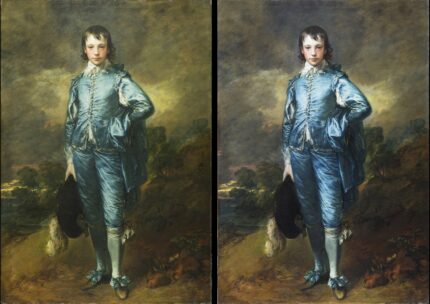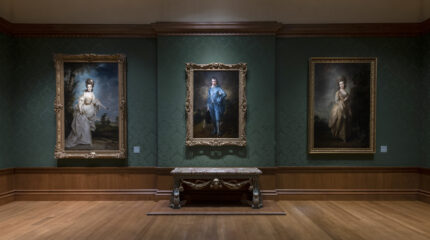After three years of restoration (plus a little pandemic thrown in there) Thomas Gainsborough’s most iconic masterpiece, The Blue Boy, has been reinstalled in the Thornton Portrait Gallery at The Huntington Library, Art Museum, and Botanical Gardens, and he is looking bluer than ever.
A Portrait of a Young Gentleman was first removed from public view in August 2017 for a thorough technical analysis and conservation program to treat long-standing structural problems, discolored varnishes, bad overpaint and flaking. A full year of that painstaking work, from September 2018 through September 2019, was undertaken in public so visitors to The Huntington could see The Blue Boy unframed as conservators cured what ailed him.
I swear the above phrasing was not intentional, but I’m keeping it in because one of the cool discoveries made during the analysis of the lining was that the adhesive Gainsborough used was a paste made of rye flour and ale. The conservation team brought in a food historian to recreate the historic recipe using modern ingredients so they could utilize it in a mock-up and study the interaction between adhesive and lining.
Christina O’Connell, The Huntington’s Mary Ann and John Sturgeon Senior Paintings Conservator and leader of the project, removed several uneven layers of dirt and discolored varnish with small cotton swabs to reveal Gainsborough’s original brilliant blues and other pigments. Then, with tiny brushes, she reconnected the artist’s brushstrokes across the voids of past damage as part of the inpainting process. As O’Connell worked on the painting, she became intimately aware of Gainsborough’s every brushstroke. “It’s been an incredibly deep professional experience,” she said. “Conservation work is very much a process of discovery. I’ve not only had a view of the painting
at the microscopic level, but I was also able to observe each stroke as the true colors of Gainsborough’s palette were revealed from underneath many layers of dirt and discolored varnish.”
During the process, O’Connell discovered that although Gainsborough painted The Blue Boy on a recycled canvas (as revealed in earlier X-rays), he made considerable use of a complex network of paint layers and pigments to create a painting that truly showed off his skills.
Gainsborough did not paint The Blue Boy on commission. He created it for the Royal Academy exhibition of 1770 to showcase his abilities in Van Dyck-style portraiture, hence the 17th century style of the boy’s striking clothing. Gainsborough’s aim was to take on the sine qua non of court portrait painters and to beat the revered Van Dyck at his own game. He succeeded. The Blue Boy was an immediate hit at the exhibition and Thomas Gainsborough, son of working class parents, vaulted up the social ranks from making portraits of merchants to painting nobles and aristocrats.
The Blue Boy was supposed to be reinstalled in March, but then the thing that happened happened, so his return was pushed back. Phased reopening has begun. For now, only the botanical gardens are open to visitors, but when the galleries reopen, he will be waiting for them with a whole new glow.

